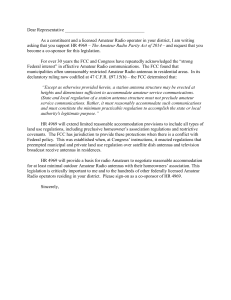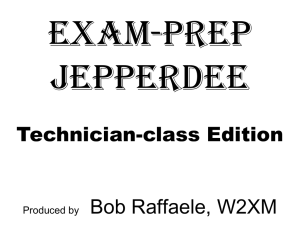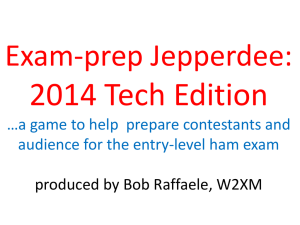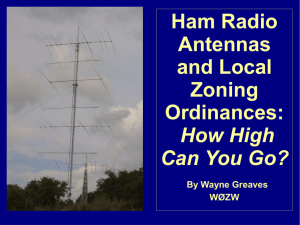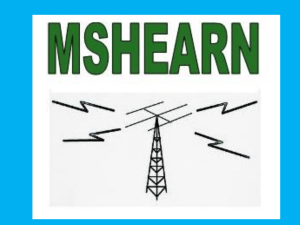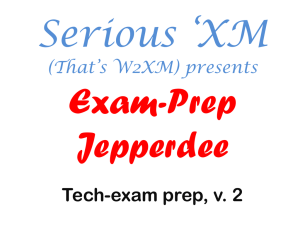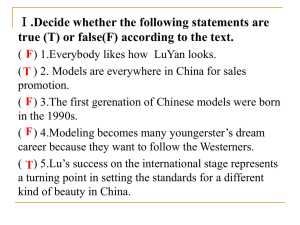Private Land Use Regulations and HR 4969
advertisement
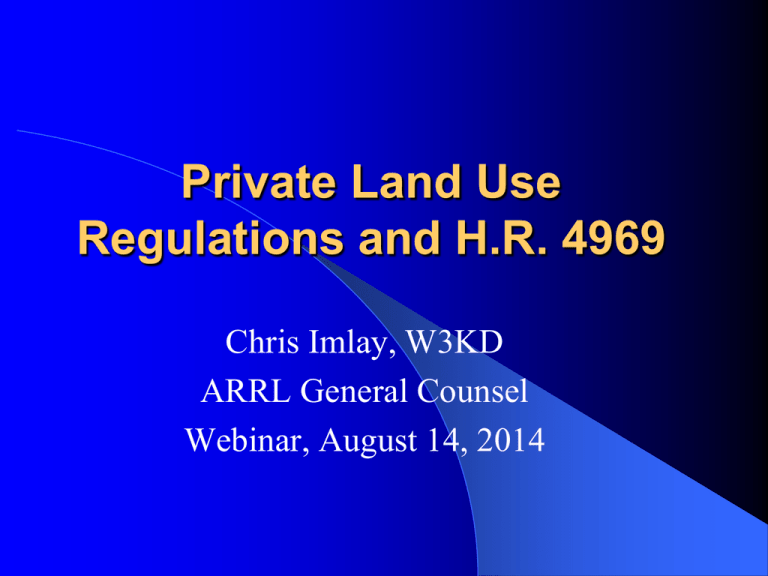
Private Land Use Regulations and H.R. 4969 Chris Imlay, W3KD ARRL General Counsel Webinar, August 14, 2014 Antennas and Amateur Radio Hierarchy of Regulatory Challenges: – Spectrum Allocations (the Big Enchilada) – Private Land Use Regulations – Municipal Antenna Regulations – FCC Service Rules and Licensing Requirements A Matter of Agreement? Theory is that the Buyer of land takes the property with notice of the restrictions imposed by the Seller or the Seller’s predecessor. Covenants “run with the land”, referenced in deeds at the time of the land transfer and are recorded among the land records, now when land is subdivided. So there is constructive notice of them for anyone buying land. In California and in some other states, buyers are required to be given a copy of the restrictions at the time of purchasing the land so that they have actual knowledge. Because the benefit of CC&Rs flow to all homeowners in the subdivision, any homeowner can enforce the covenants, or the HOA can, or the developer can before he sells all of the houses in the development and moves on. Attorney’s fees and costs assessed if you challenge the CC&Rs and lose. Lien on property for costs of HOA if a challenge to the HOA is unsuccessful. False! The premise of the Commission in creating a dichotomy between governmental land use regulation of Amateur Radio communications and private land use regulation of those same antennas was then and is now a logical and factual fallacy. The Commission assumed that CC&Rs were private contractual agreements between buyers and sellers of land that were and are in some way negotiable. The contractual characteristic of private land use regulation has not existed in the United States for a great many years. The terms of CC&Rs are not negotiable between sellers and buyers of land. Declarations of CC&Rs are in place on a comprehensive basis long before a buyer of land comes to the table. They are simply burdens on the bundle of rights of land ownership and they may not even express actual antenna restrictions. Even if private land use regulations were a matter of arms-length negotiation between buyers and sellers of land, the FCC never explained in Amateur Radio Preemption why that fact would negate the “strong Federal interest” in promoting amateur communications. PRB-1; CC&Rs “are not generally a matter of concern to the Commission” 97.15(b): Except as otherwise provided herein, a station antenna structure may be erected at heights and dimensions sufficient to accommodate amateur service communications. [State and local regulation of a station antenna structure must not preclude amateur service communications. Rather, it must reasonably accommodate such communications and must constitute the minimum practicable regulation to accomplish the state or local authority's legitimate purpose. See, PRB-1, 101 FCC 2d 952 (1985) for details.] Footnote 6 of ¶ 25 of PRB-1: “We reiterate that our ruling herein does not reach restrictive covenants in private contractual agreements. Such agreements are voluntarily entered into by the buyer or tenant when the agreement is executed and do not usually concern this Commission.” There is No Negotiation Large developments which were completed in phases utilized separate sets of comprehensive deed restrictions which were consistent in form and general approach but they were each recorded prior to any deeds to individual lot owners in each phase of the development, typically with the subdivision plat by the developer. Therefore, there were never arms-length contractual negotiations between buyers and sellers of land with respect to the restrictions. Today, developers typically adopt master restrictions applicable to an entire development and record these with the subdivision plat before the subdivision is built. Some lenders for real estate developments, perhaps most, require the declaration of CC&Rs as a condition of funding the development project. The only decision by a buyer of an individual parcel or unit is whether or not to purchase a residence in a subdivision regulated by CC&Rs in light of their burdening the development. That decision is often dictated by factors other than whether or not the buyer desires to erect and maintain an Amateur Radio antenna. OTARD The Telecommunications Act of 1996, at Section 207, directed the FCC to remove restrictions on OTARD devices: Within 180 days after the date of enactment, the Commission shall, pursuant to Section 303 of the Communications Act of 1934, promulgate regulations to prohibit restrictions that impair a viewer's ability to receive video programming services through devices designed for over-the-air reception of television broadcast signals, multichannel multipoint distribution service, or direct broadcast satellite services. Congress specifically instructed the Commission to extend this prohibition to nongovernmental restrictions such as “restrictive covenants and encumbrances.” FCC issued on August 6, 1996 a Report and Order, Memorandum Opinion and Order, and Further Notice of Proposed Rule Making ("OTARD 1") adopting rules now codified as 47 C.F.R. §1.4000. FCC Found That It Has Jurisdiction to Preempt Covenants in the OTARD Proceeding “In FCC v. Florida Power Corp. [480 U.S. 245 (1987)] the Court permitted the Commission to invalidate certain terms of private contracts relating to property rights….Courts have also found that homeowner covenants do not enjoy special immunity from federal power (citations omitted). Thus, we conclude that the authority bestowed upon the Commission to adopt a rule that prohibits restrictive covenants or other similar nongovernmental restrictions is not constitutionally infirm.” “…In proposing a strict preemption of such private restrictions without a specific rebuttal or waiver provision (footnote omitted), we noted that nongovernmental restrictions appear to be related primarily to aesthetic concerns. We tentatively concluded that it was therefore appropriate to accord them less deference than local governmental regulations that can be based on health and safety considerations…” 1999- FCC Refuses to Preempt CC&Rs Again FCC in 1999: “Notwithstanding the clear policy statement that was set forth in PRB-1 excluding restrictive covenants in private contractual agreements as being outside the reach of our limited preemption (citation to Amateur Radio Preemption omitted) we nevertheless strongly encourage associations of homeowners and private contracting parties to follow the principle of reasonable accommodation and to apply it to any and all instances of amateur service communications where they may be involved.” Some Scary Statistics As of 1998, one out of eight Americans lived in private common-interest communities (commonly referred to as “CICs”). These include Planned Unit Developments (PUDs), Master Planned Communities, condominiums, cooperatives, gated communities, and any community with a community or homeowners’ association. What all CICs have in common is that they are regulated by private land use regulations. A 1999 Gallup Organization’s survey of community association homeowner satisfaction led CAI in 2005 to conclude that “more than four in five housing starts during the past 5 to 8 years have been built as part of an associationgoverned community.” CICs now include entire cities with all of the attributes of a public city, including business districts. An example is Reston, Virginia: over 74,000 acres; population of over 35,000; 12,500 residential units; more than 500 businesses. Exponential Increases in Private Land Use Regulations CICs in the United States (i.e. association-governed communities, housing units and residents over time): Year 1970 1980 1990 2000 2002 2004 2006 2008 2010 2011 Communities 10,000 36,000 130,000 222,500 240,000 260,000 286,000 300,800 309,600 314,200 Housing Units 701,000 3.6 million 11.6 million 17.8 million 19.2 million 20.8 million 23.1 million 24.1 million 24.8 million 25.1 million Residents 2.1 million 9.6 million 29.6 million 45.2 million 48.0 million 51.8 million 57.0 million 59.5 million 62.0 million 62.3 million Types of CC&R Antenna Restrictions CC&R language with respect to antennas (as that language would apply to Amateur Radio antennas) fall into four basic categories: (A) Those which prohibit all outdoor antennas without exception. (B) Those which permit some types of antennas, usually very small OTARD antennas but prohibit all other types of antennas such as Amateur Radio antennas. (C) Those which permit antennas that are of a certain configuration, size or height, usually based on visibility from the street or from adjacent parcels of land but without regard to antenna performance. (D) Those which permit only those buildings and structures that are approved by either an Architectural Control Board or by the homeowners’ association itself. (Typically, these types of CC&R antenna restrictions do not contain any standards which might guide the Architectural Control Board or whatever the competent evaluating entity might be, or which would allow the resident to know in advance whether or not his or her antenna installation will or will not likely be approved). The Amateur Radio Parity Act of 2014: The Findings More than 700,000 radio amateurs in the United States are licensed by the Federal Communications Commission in the amateur radio service. Amateur radio, at no cost to taxpayers, provides a fertile ground for technical self-training in modern telecommunications, electronics technology, and emergency communications techniques and protocols. There is a strong Federal interest in the effective performance of amateur radio stations established at the residences of licensees. Such stations have been shown to be frequently and increasingly precluded by unreasonable private land use restrictions, including restrictive covenants. Federal Communications Commission regulations have for 28 years prohibited the application to amateur radio stations of State and local regulations that preclude or fail to reasonably accommodate amateur service communications, or that do not constitute the minimum practicable regulation to accomplish a legitimate State or local purpose. Commission policy has been and is to permit erection of a station antenna structure at heights and dimensions sufficient to accommodate amateur service communications. The Federal Communications Commission has sought guidance and direction from Congress with respect to the application of the Commission's limited preemption policy regarding amateur radio communications to private land use restrictions, including restrictive covenants. THE OPERATIVE TERMS Not later than 120 days after the date of the enactment of this Act, the Federal Communications Commission shall amend section 97.15(b) of title 47, Code of Federal Regulations, so that such section prohibits application to amateur service communications of any private land use restriction, including a restrictive covenant, that-(1) precludes such communications; (2) fails to reasonably accommodate such communications; or (3) does not constitute the minimum practicable restriction on such communications to accomplish the legitimate purpose of the private entity seeking to enforce such restriction. QUESTIONS AND ANSWERS THANKS, 73 Chris W3KD
